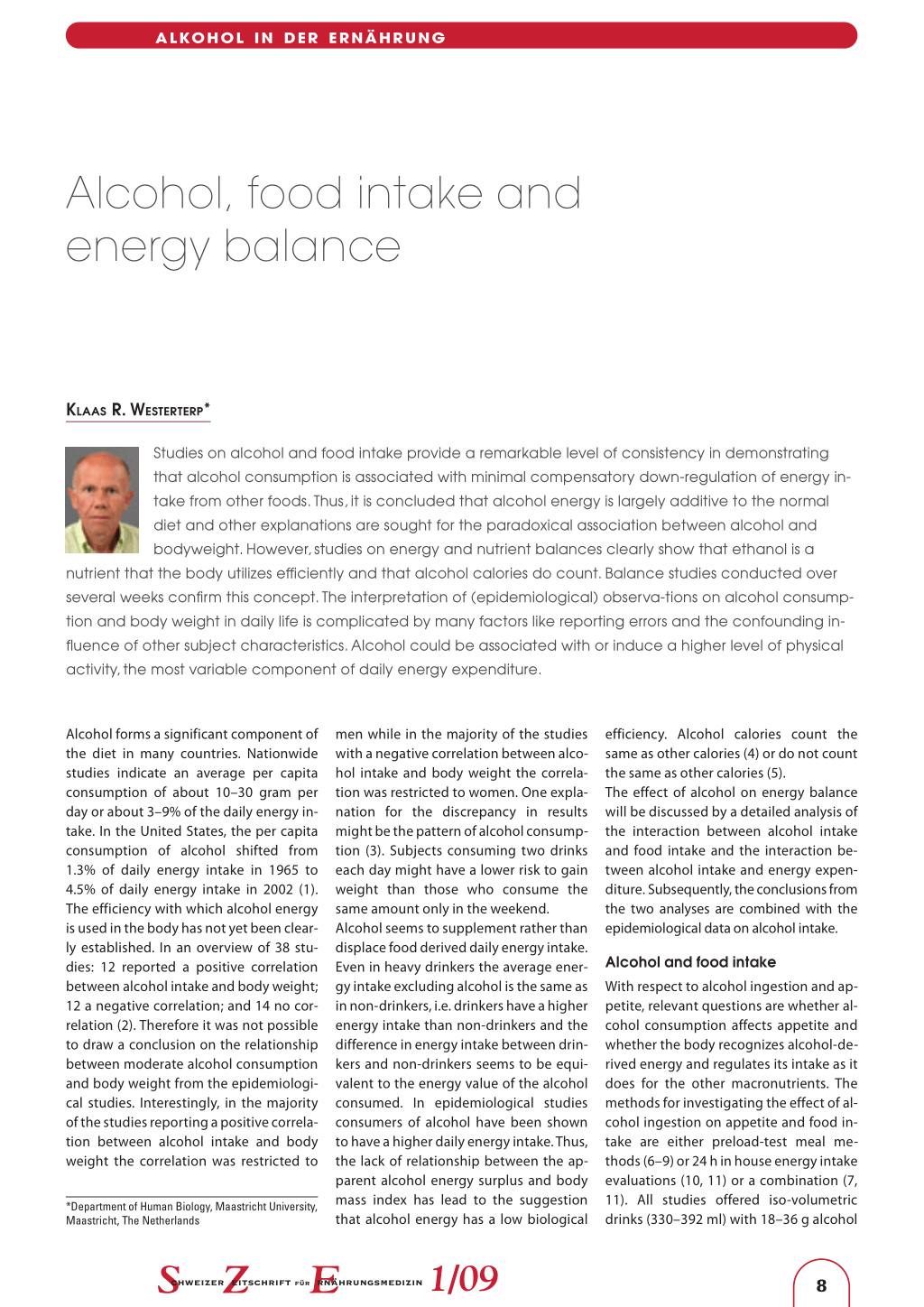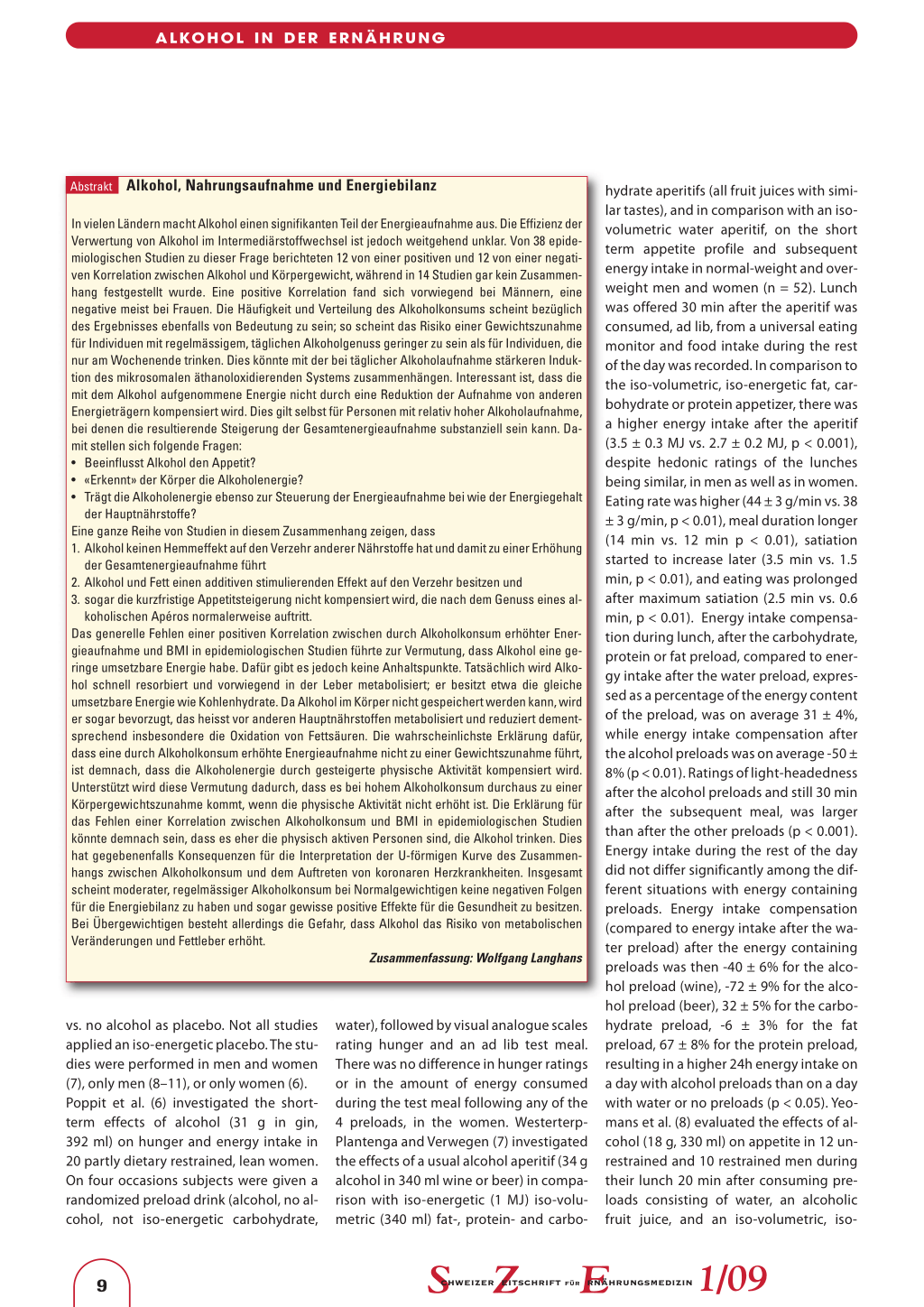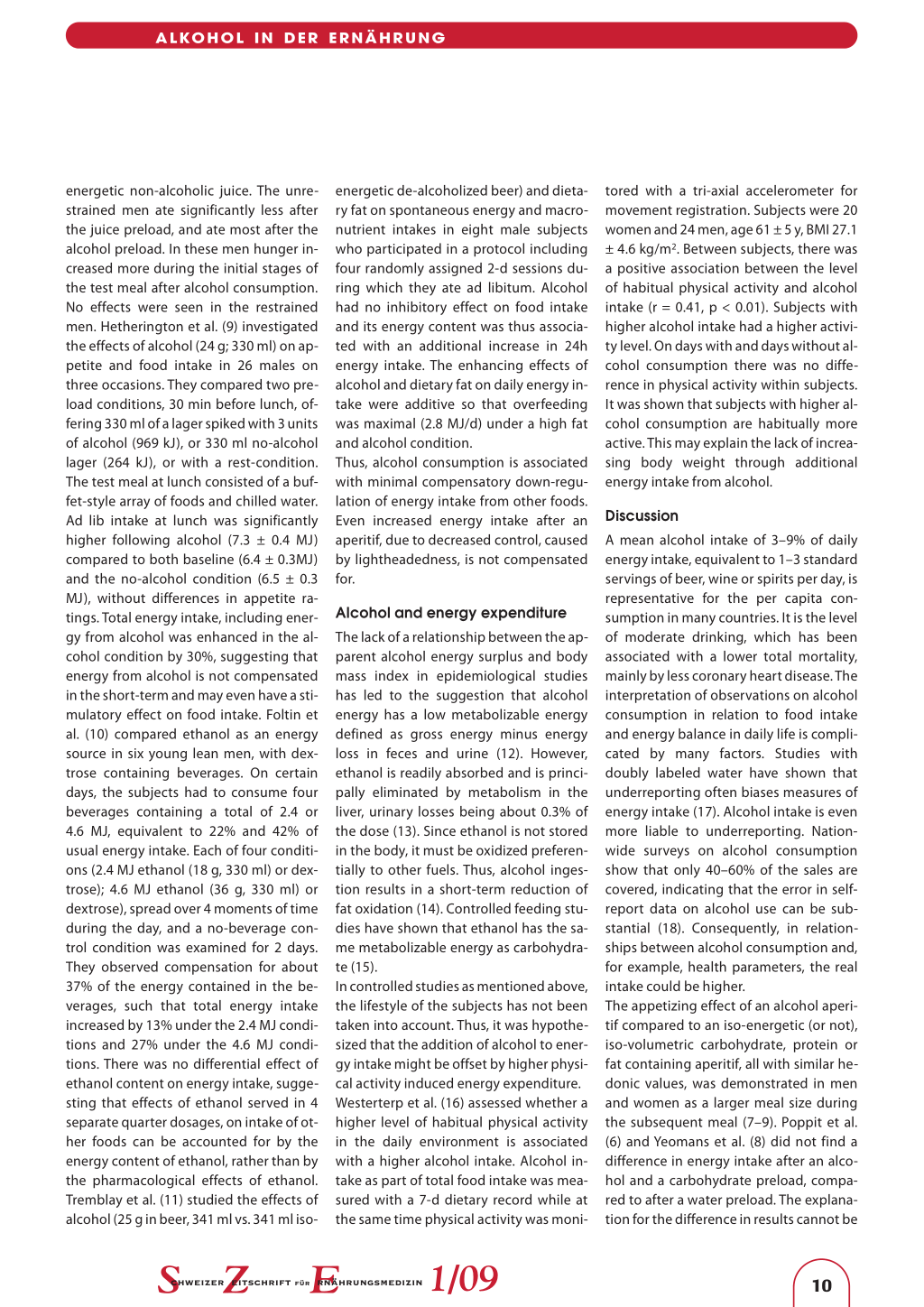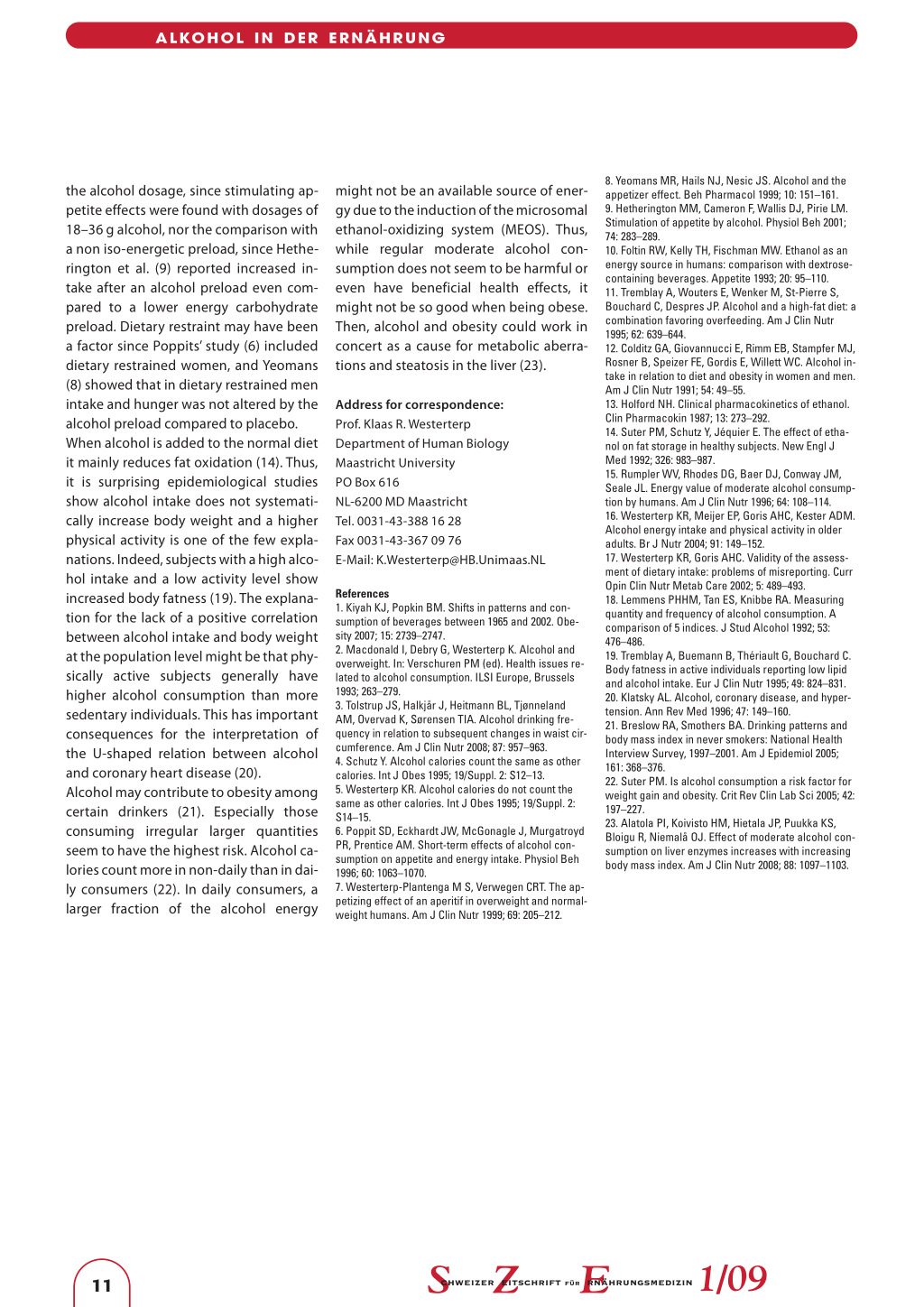Transkript
ALKOHOL IN DER ERNÄHRUNG
Alcohol, food intake and energy balance
KLAAS R. WESTERTERP*
Studies on alcohol and food intake provide a remarkable level of consistency in demonstrating that alcohol consumption is associated with minimal compensatory down-regulation of energy intake from other foods. Thus, it is concluded that alcohol energy is largely additive to the normal diet and other explanations are sought for the paradoxical association between alcohol and bodyweight. However, studies on energy and nutrient balances clearly show that ethanol is a nutrient that the body utilizes efficiently and that alcohol calories do count. Balance studies conducted over several weeks confirm this concept. The interpretation of (epidemiological) observa-tions on alcohol consumption and body weight in daily life is complicated by many factors like reporting errors and the confounding influence of other subject characteristics. Alcohol could be associated with or induce a higher level of physical activity, the most variable component of daily energy expenditure.
Alcohol forms a significant component of the diet in many countries. Nationwide studies indicate an average per capita consumption of about 10–30 gram per day or about 3–9% of the daily energy intake. In the United States, the per capita consumption of alcohol shifted from 1.3% of daily energy intake in 1965 to 4.5% of daily energy intake in 2002 (1). The efficiency with which alcohol energy is used in the body has not yet been clearly established. In an overview of 38 studies: 12 reported a positive correlation between alcohol intake and body weight; 12 a negative correlation; and 14 no correlation (2). Therefore it was not possible to draw a conclusion on the relationship between moderate alcohol consumption and body weight from the epidemiological studies. Interestingly, in the majority of the studies reporting a positive correlation between alcohol intake and body weight the correlation was restricted to
*Department of Human Biology, Maastricht University, Maastricht, The Netherlands
men while in the majority of the studies with a negative correlation between alcohol intake and body weight the correlation was restricted to women. One explanation for the discrepancy in results might be the pattern of alcohol consumption (3). Subjects consuming two drinks each day might have a lower risk to gain weight than those who consume the same amount only in the weekend. Alcohol seems to supplement rather than displace food derived daily energy intake. Even in heavy drinkers the average energy intake excluding alcohol is the same as in non-drinkers, i.e. drinkers have a higher energy intake than non-drinkers and the difference in energy intake between drinkers and non-drinkers seems to be equivalent to the energy value of the alcohol consumed. In epidemiological studies consumers of alcohol have been shown to have a higher daily energy intake. Thus, the lack of relationship between the apparent alcohol energy surplus and body mass index has lead to the suggestion that alcohol energy has a low biological
efficiency. Alcohol calories count the same as other calories (4) or do not count the same as other calories (5). The effect of alcohol on energy balance will be discussed by a detailed analysis of the interaction between alcohol intake and food intake and the interaction between alcohol intake and energy expenditure. Subsequently, the conclusions from the two analyses are combined with the epidemiological data on alcohol intake.
Alcohol and food intake
With respect to alcohol ingestion and appetite, relevant questions are whether alcohol consumption affects appetite and whether the body recognizes alcohol-derived energy and regulates its intake as it does for the other macronutrients. The methods for investigating the effect of alcohol ingestion on appetite and food intake are either preload-test meal methods (6–9) or 24 h in house energy intake evaluations (10, 11) or a combination (7, 11). All studies offered iso-volumetric drinks (330–392 ml) with 18–36 g alcohol
1/09
8
ALKOHOL IN DER ERNÄHRUNG
Abstrakt Alkohol, Nahrungsaufnahme und Energiebilanz
In vielen Ländern macht Alkohol einen signifikanten Teil der Energieaufnahme aus. Die Effizienz der Verwertung von Alkohol im Intermediärstoffwechsel ist jedoch weitgehend unklar. Von 38 epidemiologischen Studien zu dieser Frage berichteten 12 von einer positiven und 12 von einer negativen Korrelation zwischen Alkohol und Körpergewicht, während in 14 Studien gar kein Zusammenhang festgestellt wurde. Eine positive Korrelation fand sich vorwiegend bei Männern, eine negative meist bei Frauen. Die Häufigkeit und Verteilung des Alkoholkonsums scheint bezüglich des Ergebnisses ebenfalls von Bedeutung zu sein; so scheint das Risiko einer Gewichtszunahme für Individuen mit regelmässigem, täglichen Alkoholgenuss geringer zu sein als für Individuen, die nur am Wochenende trinken. Dies könnte mit der bei täglicher Alkoholaufnahme stärkeren Induktion des mikrosomalen äthanoloxidierenden Systems zusammenhängen. Interessant ist, dass die mit dem Alkohol aufgenommene Energie nicht durch eine Reduktion der Aufnahme von anderen Energieträgern kompensiert wird. Dies gilt selbst für Personen mit relativ hoher Alkoholaufnahme, bei denen die resultierende Steigerung der Gesamtenergieaufnahme substanziell sein kann. Damit stellen sich folgende Fragen: • Beeinflusst Alkohol den Appetit? • «Erkennt» der Körper die Alkoholenergie? • Trägt die Alkoholenergie ebenso zur Steuerung der Energieaufnahme bei wie der Energiegehalt
der Hauptnährstoffe? Eine ganze Reihe von Studien in diesem Zusammenhang zeigen, dass 1. Alkohol keinen Hemmeffekt auf den Verzehr anderer Nährstoffe hat und damit zu einer Erhöhung
der Gesamtenergieaufnahme führt 2. Alkohol und Fett einen additiven stimulierenden Effekt auf den Verzehr besitzen und 3. sogar die kurzfristige Appetitsteigerung nicht kompensiert wird, die nach dem Genuss eines al-
koholischen Apéros normalerweise auftritt. Das generelle Fehlen einer positiven Korrelation zwischen durch Alkoholkonsum erhöhter Energieaufnahme und BMI in epidemiologischen Studien führte zur Vermutung, dass Alkohol eine geringe umsetzbare Energie habe. Dafür gibt es jedoch keine Anhaltspunkte. Tatsächlich wird Alkohol schnell resorbiert und vorwiegend in der Leber metabolisiert; er besitzt etwa die gleiche umsetzbare Energie wie Kohlenhydrate. Da Alkohol im Körper nicht gespeichert werden kann, wird er sogar bevorzugt, das heisst vor anderen Hauptnährstoffen metabolisiert und reduziert dementsprechend insbesondere die Oxidation von Fettsäuren. Die wahrscheinlichste Erklärung dafür, dass eine durch Alkoholkonsum erhöhte Energieaufnahme nicht zu einer Gewichtszunahme führt, ist demnach, dass die Alkoholenergie durch gesteigerte physische Aktivität kompensiert wird. Unterstützt wird diese Vermutung dadurch, dass es bei hohem Alkoholkonsum durchaus zu einer Körpergewichtszunahme kommt, wenn die physische Aktivität nicht erhöht ist. Die Erklärung für das Fehlen einer Korrelation zwischen Alkoholkonsum und BMI in epidemiologischen Studien könnte demnach sein, dass es eher die physisch aktiven Personen sind, die Alkohol trinken. Dies hat gegebenenfalls Konsequenzen für die Interpretation der U-förmigen Kurve des Zusammenhangs zwischen Alkoholkonsum und dem Auftreten von koronaren Herzkrankheiten. Insgesamt scheint moderater, regelmässiger Alkoholkonsum bei Normalgewichtigen keine negativen Folgen für die Energiebilanz zu haben und sogar gewisse positive Effekte für die Gesundheit zu besitzen. Bei Übergewichtigen besteht allerdings die Gefahr, dass Alkohol das Risiko von metabolischen Veränderungen und Fettleber erhöht.
Zusammenfassung: Wolfgang Langhans
vs. no alcohol as placebo. Not all studies applied an iso-energetic placebo. The studies were performed in men and women (7), only men (8–11), or only women (6). Poppit et al. (6) investigated the shortterm effects of alcohol (31 g in gin, 392 ml) on hunger and energy intake in 20 partly dietary restrained, lean women. On four occasions subjects were given a randomized preload drink (alcohol, no alcohol, not iso-energetic carbohydrate,
water), followed by visual analogue scales rating hunger and an ad lib test meal. There was no difference in hunger ratings or in the amount of energy consumed during the test meal following any of the 4 preloads, in the women. WesterterpPlantenga and Verwegen (7) investigated the effects of a usual alcohol aperitif (34 g alcohol in 340 ml wine or beer) in comparison with iso-energetic (1 MJ) iso-volumetric (340 ml) fat-, protein- and carbo-
hydrate aperitifs (all fruit juices with similar tastes), and in comparison with an isovolumetric water aperitif, on the short term appetite profile and subsequent energy intake in normal-weight and overweight men and women (n = 52). Lunch was offered 30 min after the aperitif was consumed, ad lib, from a universal eating monitor and food intake during the rest of the day was recorded. In comparison to the iso-volumetric, iso-energetic fat, carbohydrate or protein appetizer, there was a higher energy intake after the aperitif (3.5 ± 0.3 MJ vs. 2.7 ± 0.2 MJ, p < 0.001), despite hedonic ratings of the lunches being similar, in men as well as in women. Eating rate was higher (44 ± 3 g/min vs. 38 ± 3 g/min, p < 0.01), meal duration longer (14 min vs. 12 min p < 0.01), satiation started to increase later (3.5 min vs. 1.5 min, p < 0.01), and eating was prolonged after maximum satiation (2.5 min vs. 0.6 min, p < 0.01). Energy intake compensation during lunch, after the carbohydrate, protein or fat preload, compared to energy intake after the water preload, expressed as a percentage of the energy content of the preload, was on average 31 ± 4%, while energy intake compensation after the alcohol preloads was on average -50 ± 8% (p < 0.01). Ratings of light-headedness after the alcohol preloads and still 30 min after the subsequent meal, was larger than after the other preloads (p < 0.001). Energy intake during the rest of the day did not differ significantly among the different situations with energy containing preloads. Energy intake compensation (compared to energy intake after the water preload) after the energy containing preloads was then -40 ± 6% for the alcohol preload (wine), -72 ± 9% for the alcohol preload (beer), 32 ± 5% for the carbohydrate preload, -6 ± 3% for the fat preload, 67 ± 8% for the protein preload, resulting in a higher 24h energy intake on a day with alcohol preloads than on a day with water or no preloads (p < 0.05). Yeomans et al. (8) evaluated the effects of alcohol (18 g, 330 ml) on appetite in 12 unrestrained and 10 restrained men during their lunch 20 min after consuming preloads consisting of water, an alcoholic fruit juice, and an iso-volumetric, iso- 9 1/09 ALKOHOL IN DER ERNÄHRUNG energetic non-alcoholic juice. The unrestrained men ate significantly less after the juice preload, and ate most after the alcohol preload. In these men hunger increased more during the initial stages of the test meal after alcohol consumption. No effects were seen in the restrained men. Hetherington et al. (9) investigated the effects of alcohol (24 g; 330 ml) on appetite and food intake in 26 males on three occasions. They compared two preload conditions, 30 min before lunch, offering 330 ml of a lager spiked with 3 units of alcohol (969 kJ), or 330 ml no-alcohol lager (264 kJ), or with a rest-condition. The test meal at lunch consisted of a buffet-style array of foods and chilled water. Ad lib intake at lunch was significantly higher following alcohol (7.3 ± 0.4 MJ) compared to both baseline (6.4 ± 0.3MJ) and the no-alcohol condition (6.5 ± 0.3 MJ), without differences in appetite ratings. Total energy intake, including energy from alcohol was enhanced in the alcohol condition by 30%, suggesting that energy from alcohol is not compensated in the short-term and may even have a stimulatory effect on food intake. Foltin et al. (10) compared ethanol as an energy source in six young lean men, with dextrose containing beverages. On certain days, the subjects had to consume four beverages containing a total of 2.4 or 4.6 MJ, equivalent to 22% and 42% of usual energy intake. Each of four conditions (2.4 MJ ethanol (18 g, 330 ml) or dextrose); 4.6 MJ ethanol (36 g, 330 ml) or dextrose), spread over 4 moments of time during the day, and a no-beverage control condition was examined for 2 days. They observed compensation for about 37% of the energy contained in the beverages, such that total energy intake increased by 13% under the 2.4 MJ conditions and 27% under the 4.6 MJ conditions. There was no differential effect of ethanol content on energy intake, suggesting that effects of ethanol served in 4 separate quarter dosages, on intake of other foods can be accounted for by the energy content of ethanol, rather than by the pharmacological effects of ethanol. Tremblay et al. (11) studied the effects of alcohol (25 g in beer, 341 ml vs. 341 ml iso- energetic de-alcoholized beer) and dietary fat on spontaneous energy and macronutrient intakes in eight male subjects who participated in a protocol including four randomly assigned 2-d sessions during which they ate ad libitum. Alcohol had no inhibitory effect on food intake and its energy content was thus associated with an additional increase in 24h energy intake. The enhancing effects of alcohol and dietary fat on daily energy intake were additive so that overfeeding was maximal (2.8 MJ/d) under a high fat and alcohol condition. Thus, alcohol consumption is associated with minimal compensatory down-regulation of energy intake from other foods. Even increased energy intake after an aperitif, due to decreased control, caused by lightheadedness, is not compensated for. Alcohol and energy expenditure The lack of a relationship between the apparent alcohol energy surplus and body mass index in epidemiological studies has led to the suggestion that alcohol energy has a low metabolizable energy defined as gross energy minus energy loss in feces and urine (12). However, ethanol is readily absorbed and is principally eliminated by metabolism in the liver, urinary losses being about 0.3% of the dose (13). Since ethanol is not stored in the body, it must be oxidized preferentially to other fuels. Thus, alcohol ingestion results in a short-term reduction of fat oxidation (14). Controlled feeding studies have shown that ethanol has the same metabolizable energy as carbohydrate (15). In controlled studies as mentioned above, the lifestyle of the subjects has not been taken into account. Thus, it was hypothesized that the addition of alcohol to energy intake might be offset by higher physical activity induced energy expenditure. Westerterp et al. (16) assessed whether a higher level of habitual physical activity in the daily environment is associated with a higher alcohol intake. Alcohol intake as part of total food intake was measured with a 7-d dietary record while at the same time physical activity was moni- tored with a tri-axial accelerometer for movement registration. Subjects were 20 women and 24 men, age 61 ± 5 y, BMI 27.1 ± 4.6 kg/m2. Between subjects, there was a positive association between the level of habitual physical activity and alcohol intake (r = 0.41, p < 0.01). Subjects with higher alcohol intake had a higher activity level. On days with and days without alcohol consumption there was no difference in physical activity within subjects. It was shown that subjects with higher alcohol consumption are habitually more active. This may explain the lack of increasing body weight through additional energy intake from alcohol. Discussion A mean alcohol intake of 3–9% of daily energy intake, equivalent to 1–3 standard servings of beer, wine or spirits per day, is representative for the per capita consumption in many countries. It is the level of moderate drinking, which has been associated with a lower total mortality, mainly by less coronary heart disease. The interpretation of observations on alcohol consumption in relation to food intake and energy balance in daily life is complicated by many factors. Studies with doubly labeled water have shown that underreporting often biases measures of energy intake (17). Alcohol intake is even more liable to underreporting. Nationwide surveys on alcohol consumption show that only 40–60% of the sales are covered, indicating that the error in selfreport data on alcohol use can be substantial (18). Consequently, in relationships between alcohol consumption and, for example, health parameters, the real intake could be higher. The appetizing effect of an alcohol aperitif compared to an iso-energetic (or not), iso-volumetric carbohydrate, protein or fat containing aperitif, all with similar hedonic values, was demonstrated in men and women as a larger meal size during the subsequent meal (7–9). Poppit et al. (6) and Yeomans et al. (8) did not find a difference in energy intake after an alcohol and a carbohydrate preload, compared to after a water preload. The explanation for the difference in results cannot be 1/09 10 ALKOHOL IN DER ERNÄHRUNG the alcohol dosage, since stimulating appetite effects were found with dosages of 18–36 g alcohol, nor the comparison with a non iso-energetic preload, since Hetherington et al. (9) reported increased intake after an alcohol preload even compared to a lower energy carbohydrate preload. Dietary restraint may have been a factor since Poppits’ study (6) included dietary restrained women, and Yeomans (8) showed that in dietary restrained men intake and hunger was not altered by the alcohol preload compared to placebo. When alcohol is added to the normal diet it mainly reduces fat oxidation (14). Thus, it is surprising epidemiological studies show alcohol intake does not systematically increase body weight and a higher physical activity is one of the few explanations. Indeed, subjects with a high alcohol intake and a low activity level show increased body fatness (19). The explanation for the lack of a positive correlation between alcohol intake and body weight at the population level might be that physically active subjects generally have higher alcohol consumption than more sedentary individuals. This has important consequences for the interpretation of the U-shaped relation between alcohol and coronary heart disease (20). Alcohol may contribute to obesity among certain drinkers (21). Especially those consuming irregular larger quantities seem to have the highest risk. Alcohol calories count more in non-daily than in daily consumers (22). In daily consumers, a larger fraction of the alcohol energy might not be an available source of energy due to the induction of the microsomal ethanol-oxidizing system (MEOS). Thus, while regular moderate alcohol consumption does not seem to be harmful or even have beneficial health effects, it might not be so good when being obese. Then, alcohol and obesity could work in concert as a cause for metabolic aberrations and steatosis in the liver (23). Address for correspondence: Prof. Klaas R. Westerterp Department of Human Biology Maastricht University PO Box 616 NL-6200 MD Maastricht Tel. 0031-43-388 16 28 Fax 0031-43-367 09 76 E-Mail: K.Westerterp@HB.Unimaas.NL References 1. Kiyah KJ, Popkin BM. Shifts in patterns and consumption of beverages between 1965 and 2002. Obesity 2007; 15: 2739–2747. 2. Macdonald I, Debry G, Westerterp K. Alcohol and overweight. In: Verschuren PM (ed). Health issues related to alcohol consumption. ILSI Europe, Brussels 1993; 263–279. 3. Tolstrup JS, Halkjår J, Heitmann BL, Tjønneland AM, Overvad K, Sørensen TIA. Alcohol drinking frequency in relation to subsequent changes in waist circumference. Am J Clin Nutr 2008; 87: 957–963. 4. Schutz Y. Alcohol calories count the same as other calories. Int J Obes 1995; 19/Suppl. 2: S12–13. 5. Westerterp KR. Alcohol calories do not count the same as other calories. Int J Obes 1995; 19/Suppl. 2: S14–15. 6. Poppit SD, Eckhardt JW, McGonagle J, Murgatroyd PR, Prentice AM. Short-term effects of alcohol consumption on appetite and energy intake. Physiol Beh 1996; 60: 1063–1070. 7. Westerterp-Plantenga M S, Verwegen CRT. The appetizing effect of an aperitif in overweight and normalweight humans. Am J Clin Nutr 1999; 69: 205–212. 8. Yeomans MR, Hails NJ, Nesic JS. Alcohol and the appetizer effect. Beh Pharmacol 1999; 10: 151–161. 9. Hetherington MM, Cameron F, Wallis DJ, Pirie LM. Stimulation of appetite by alcohol. Physiol Beh 2001; 74: 283–289. 10. Foltin RW, Kelly TH, Fischman MW. Ethanol as an energy source in humans: comparison with dextrosecontaining beverages. Appetite 1993; 20: 95–110. 11. Tremblay A, Wouters E, Wenker M, St-Pierre S, Bouchard C, Despres JP. Alcohol and a high-fat diet: a combination favoring overfeeding. Am J Clin Nutr 1995; 62: 639–644. 12. Colditz GA, Giovannucci E, Rimm EB, Stampfer MJ, Rosner B, Speizer FE, Gordis E, Willett WC. Alcohol intake in relation to diet and obesity in women and men. Am J Clin Nutr 1991; 54: 49–55. 13. Holford NH. Clinical pharmacokinetics of ethanol. Clin Pharmacokin 1987; 13: 273–292. 14. Suter PM, Schutz Y, Jéquier E. The effect of ethanol on fat storage in healthy subjects. New Engl J Med 1992; 326: 983–987. 15. Rumpler WV, Rhodes DG, Baer DJ, Conway JM, Seale JL. Energy value of moderate alcohol consumption by humans. Am J Clin Nutr 1996; 64: 108–114. 16. Westerterp KR, Meijer EP, Goris AHC, Kester ADM. Alcohol energy intake and physical activity in older adults. Br J Nutr 2004; 91: 149–152. 17. Westerterp KR, Goris AHC. Validity of the assessment of dietary intake: problems of misreporting. Curr Opin Clin Nutr Metab Care 2002; 5: 489–493. 18. Lemmens PHHM, Tan ES, Knibbe RA. Measuring quantity and frequency of alcohol consumption. A comparison of 5 indices. J Stud Alcohol 1992; 53: 476–486. 19. Tremblay A, Buemann B, Thériault G, Bouchard C. Body fatness in active individuals reporting low lipid and alcohol intake. Eur J Clin Nutr 1995; 49: 824–831. 20. Klatsky AL. Alcohol, coronary disease, and hypertension. Ann Rev Med 1996; 47: 149–160. 21. Breslow RA, Smothers BA. Drinking patterns and body mass index in never smokers: National Health Interview Survey, 1997–2001. Am J Epidemiol 2005; 161: 368–376. 22. Suter PM. Is alcohol consumption a risk factor for weight gain and obesity. Crit Rev Clin Lab Sci 2005; 42: 197–227. 23. Alatola PI, Koivisto HM, Hietala JP, Puukka KS, Bloigu R, Niemalå OJ. Effect of moderate alcohol consumption on liver enzymes increases with increasing body mass index. Am J Clin Nutr 2008; 88: 1097–1103. 11 1/09



